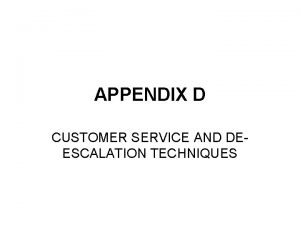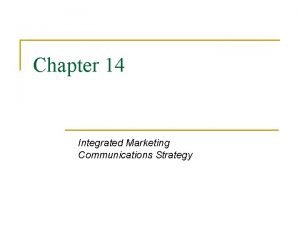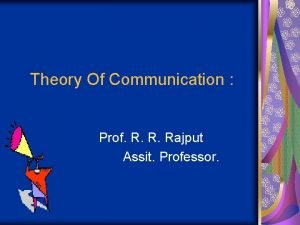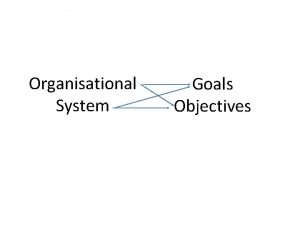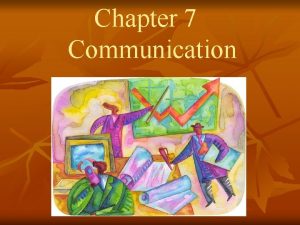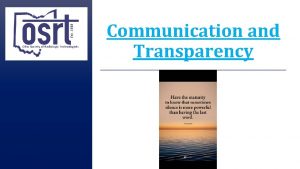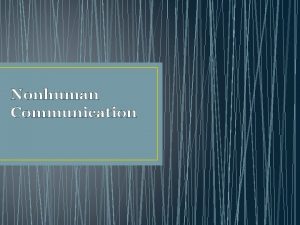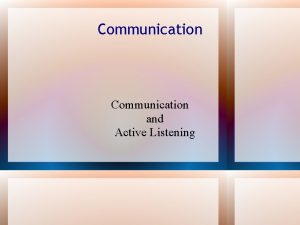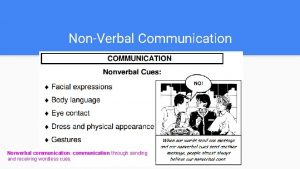Communication and Deescalation THE GOALS OF DEESCALATION AND






































- Slides: 38

Communication and De-escalation

THE GOALS OF DE-ESCALATION AND SURVIVING VERBAL CONFLICT: Ø Prevention Problem Resolution Ø Provide staff with expanded de-escalation tools/skills Ø Continue to improve relationships with the community Ø Decrease community complaints/damage control Ø

Conflict Is Inevitable…… Instead of looking at conflict as a WINLOSE situation which is usually a temporary fix bringing about resentment, bad feelings, and potentially bring future problems, look at it as an opportunity to find a WIN-WIN solution from which both sides can benefit. That approach is a cornerstone of conflict resolution.

Empathy What’s It’s the definition of Empathy? the ability to see the world through the eyes of another, and is far different from sympathy.

Definitions Crisis: any situation in which a person’s ability to cope is exceeded. (Hoff, 1968) Examples: Barricaded subjects Domestic violence Substance Abuse High risk suicide Mental illness Violence in the workplace Crisis Intervention: the short-term, time-limited intervention, designed to reestablish a person’s equilibrium and to solve an immediate problem (Hoff)

Types of unexpected events that influence crisis: Divorce Loss of a job Sickness, injury or death Deterioration of mental health Loss of health Demotion or loss of status Interruption of plan-police intervention

Methods of Gaining Compliance POWER ◦ Physics ◦ Force INFLUENCE ◦ Psychology ◦ Magic

Rhetorical Triangle-Aristotle’s Art of Persuasion ETHOS (credibility, ethical appeal): ü The speaker’s authority, credibility, respect, fairness, and believability. Based on how you carry yourself; Dress for success; Are you looking the part? Most people agree with the uniform and respect it…If not, it’s a CLUE! LOGOS (logical appeal): ü Persuading by the use of reasoning, evidence, logic, reasoning, and facts used to support a position. Most important of appeals. PATHOS (Persuasive appeal): ü Appeals to a person’s sense of identity, values, self interest, and emotions. Emotional effect of speaker’s words.

Three Types of People AGREEABLE: ü Those that do what you say. CHALLENGING: ü Those that talk “junk” right off the bat. They want to know “WHY? ” You will most likely see it coming. MANIPULATOR: ü “SNEAKY”. Tries to run the show, push your buttons. They will try to show cooperation, but will be planning something else. Most dangerous - especially if staff is unaware. They can hurt you!. . .

Identifying Threats How are they What is their talking? voice tone? What is their behavior like? ¨Respectful ¨Normal ¨Compliant ¨Negative ¨Loud ¨Passive ¨Abusive ¨Angry ¨Derogatory ¨Rageful ¨Threatening ¨Mimicking Resistant ¨Active Resistant ¨Assaultive ¨Deadly Assaultive

Roles Observer/Reinforcer Problem Solver Mediator/Negotiator Enforcer/Rescuer

When it’s “time to continue or disengage and call for assistance” Attack: Acts or perceived acts of violence, or aggression, directed toward an staff or others. Recognition of preattack indicators and/or other non-verbal clues compromising safety and security. Security: When staff/citizen safety and security interests demand immediate action due to a threat. Confirmed Non-Compliance: Exhaustion of the steps to consider when meeting verbal abuse and resistance. Disengage and call for assistance.

VERBAL CONTACT AND COVER “Never argue with a fool. Onlookers may not be able to tell the difference. ” - Mark Twain Remember: Audiences to any given event are made, not found. Are you going to make the audience or will the subject(s) - Aristotle

Contact and Cover Verbal cues Non-verbal cues Environmental factors Others in the room / building One voice at a time

Communications During a Crisis

Establishing contact: Opening statements should be designed to promote productive communication. Engaging in high risk situations ◦ Tone should be directive and instructions specific to what needs to occur in order to stabilize the situation. ◦ Identify self as security/staff. ◦ Staff must be prepared to shift to crisis intervention to gain compliance

Engaging in low to moderate risk situations If practical, monitor behavior prior to approach. Assume a calm, non-threatening manner. Consider personal space issues. Self introduction Statements should clearly identify position as security/staff.

Introduction of Officer to Person in Crisis: I am _______ of the ______. I would like to help you with your situation. My name is _____and I am with the _______. I would like to talk to you about what has happened today. I understand that there is a problem and I would like to help.

Defusing, Building Rapport, & Establishing Communications Calming Techniques ◦ Show empathy and understanding Attempt to calm an agitated subject by showing an understanding of his/her feelings. ◦ Use modeling Attempt to calm by displaying own calmness. Speak slowly and evenly.

Calming Techniques (cont’d) Reassure ◦ Calm the agitated subject by reassuring his/her fears. Assure safety. Allow ventilation ◦ Attempt to calm an agitated subject by encouraging communication. Allow person to unload but don’t get so caught up that you forget to work on solving the problem.

Reflecting on Statements (Encourages communication) Responding to statements made by the subject to encourage him to continue talking. Examples: ◦ I see… ◦ Tell me about it… ◦ That would be one option ◦ What other options do you have? ◦ Uh huh, ok…

Active Listening There are four types of active listening that staff can use during crisis intervention. Each has its own set of advantages and each is used for different purposes. Paraphrasing-a response in which staff gives to the subject the essence of his message in the staff’s words. ◦ Paraphrasing is helpful when the staff needs to respond to the subject, but does not know what to say. It demonstrates that the staf has been listening. It is not necessarily “parrot back” but puts the subject’s meaning into the staff’s words.

Active listening (cont’d) Reflecting feelings- a response in which the staff mirrors back to the subject the emotions the subject is communicating. Reflecting feelings helps develop the rapport between the staff and subjects. It moves the discussion off the factual level to the emotional level. It helps validate the subject as a person.

Active listening (cont’d) Reflecting meaning- a response in which staff let the subject know they understand the facts and feelings the subject is communicating. Reflection of meaning is used to help identify the subject’s needs and to strengthen the relationship. It helps validate the subject and reflects the implications of a situation for the subject.

Active listening (cont’d) Summative reflections- a response in which the staff summarizes the main facts and feelings that the subject has expressed over a relatively long period. Summative reflection is used to confirm information and to solidify the relationship. It reminds the subject of how far negotiations have come and how much more under control things are now than they were at first. It clarifies issues in a concise way that serves to focus staff and subject on the relevant issues.

Avoiding Roadblocks Goal: to communicate to the person that they are respected and understood. ◦ General Principles Let person talk without interruption. Avoid interrupting or explaining away person’s experience. Listener does not talk about their own opinions or advise on unrelated experience. Listen without judging.

Avoiding Roadblocks (cont’d) General Principles (cont’d) ◦ Reflect feeling ◦ Repeat main point ◦ Agree with speaker’s reaction when listener has had similar experience.

Avoiding Roadblocks (cont’d) Three traps for the staff member ◦ Talking instead of listening ◦ Not acknowledging emotional state (feelings) ◦ Not maintaining control by guiding problem toward resolution

Deflection as Persuasion

Strategic Considerations when Dealing with Difficult People Your perception of the situation Action to be Taken Verbally and Non-Verbally Compliant and Cooperative Use normal modes of communication Verbally Negative while Nonverbally Compliant Use psychologically based communication Verbally Assaultive while Non. Verbally Compliant Use hard style verbal tactics Verbally Negative and Non. Verbally Non-Compliant Call for assistance - security Verbally Assaultive and Non. Verbally Non-Compliant Call for assistance - security Non-Verbally Assaultive Call 911

Hard Style Verbalizations Ask for Compliance Set Context- Company Policies Present Options- Comply or Else Repeat Actions Call for assistance – Security/Police intervention

Frustrated & Emotionally Distraught Behavior: This person exhibits a variety of emotions that may change. Typical emotions may vary from depression to anger to anxiety. The person exhibits behavioral signs of being upset. Effects on Others: The staff’s reaction to this type of individual will vary according to the emotion expressed. ◦ ◦ ◦ ◦ How to handle Identify yourself and give the purpose of your contact Listen Acknowledge the person’s frustration Give them a lot of empathy Let them run down Provide them with support and alternatives Give specific suggestions for them to regain internal control or calm down ◦ Do not make statements such as “relax” or “calm down”

Hostile Aggressive Behavior How to Handle Do not allow the other person to grandstand in front of others Bring them aside so the audience is removed Listen to their complaints Get them to behave as others If the individual does not respond, set a limit and provide them an alternative Maintain eye contact Do not allow individual to become verbally or physically abusive State opinions and directives forcefully Be ready to be friendly if the behavior changes Maintain calm but firm tone of voice Use diversions such as asking the person to sit down

Substance Induced Behavior: The individual is in a substance– induced state precipitated by either alcohol or narcotics. They may have rapidly cycling emotions or maintain either and agitated or despondent state. Effects on Others: The main reaction experienced when dealing with this type of person is one of frustration.

Substance Induced Behavior How to Handle Substance induced reactions are basically unpredictable and therefore can become somewhat dangerous The longer a person is allowed to carry on, the more potential for problems. Stay calm but set firm limits. This person should be escorted out as quickly as possible. The same behavioral strategy should be initiated if the acting out is substance abuse induced, but resulting from a thought disorder.

5 Universal Truths to Consider: All people want to be treated with DIGNITY and RESPECT. All people want to be ASKED rather than being TOLD to do something. All people want to be told WHY they are being asked to do something. All people want to be given OPTIONS rather than THREAT. All people want a SECOND CHANCE.

The Bystander Effect

Conclusion The science of communication is difficult and much more complex than most people realize. Effective communication takes rehearsal and practice just as any other skill does. Communication involves sending and receiving. Many people learn to be effective senders, and give no effort to becoming active listeners. Unless a person is able to do both s/he will not be an effective communicator.
 Customer service deescalation
Customer service deescalation Strategic goals tactical goals operational goals
Strategic goals tactical goals operational goals Strategic goals tactical goals operational goals
Strategic goals tactical goals operational goals General goals and specific goals
General goals and specific goals Examples of generic goals and product-specific goals
Examples of generic goals and product-specific goals Typical goals of communication by seitel
Typical goals of communication by seitel Communication goals marketing
Communication goals marketing Therapeutic objectives meaning
Therapeutic objectives meaning Goals of communication
Goals of communication Instrumental goals interpersonal communication
Instrumental goals interpersonal communication Hình ảnh bộ gõ cơ thể búng tay
Hình ảnh bộ gõ cơ thể búng tay Ng-html
Ng-html Bổ thể
Bổ thể Tỉ lệ cơ thể trẻ em
Tỉ lệ cơ thể trẻ em Chó sói
Chó sói Chụp tư thế worms-breton
Chụp tư thế worms-breton Chúa yêu trần thế
Chúa yêu trần thế Môn thể thao bắt đầu bằng từ đua
Môn thể thao bắt đầu bằng từ đua Thế nào là hệ số cao nhất
Thế nào là hệ số cao nhất Các châu lục và đại dương trên thế giới
Các châu lục và đại dương trên thế giới Công thức tiính động năng
Công thức tiính động năng Trời xanh đây là của chúng ta thể thơ
Trời xanh đây là của chúng ta thể thơ Mật thư tọa độ 5x5
Mật thư tọa độ 5x5 Phép trừ bù
Phép trừ bù Phản ứng thế ankan
Phản ứng thế ankan Các châu lục và đại dương trên thế giới
Các châu lục và đại dương trên thế giới Thơ thất ngôn tứ tuyệt đường luật
Thơ thất ngôn tứ tuyệt đường luật Quá trình desamine hóa có thể tạo ra
Quá trình desamine hóa có thể tạo ra Một số thể thơ truyền thống
Một số thể thơ truyền thống Cái miệng xinh xinh thế chỉ nói điều hay thôi
Cái miệng xinh xinh thế chỉ nói điều hay thôi Vẽ hình chiếu vuông góc của vật thể sau
Vẽ hình chiếu vuông góc của vật thể sau Biện pháp chống mỏi cơ
Biện pháp chống mỏi cơ đặc điểm cơ thể của người tối cổ
đặc điểm cơ thể của người tối cổ V cc cc
V cc cc Vẽ hình chiếu đứng bằng cạnh của vật thể
Vẽ hình chiếu đứng bằng cạnh của vật thể Phối cảnh
Phối cảnh Thẻ vin
Thẻ vin đại từ thay thế
đại từ thay thế điện thế nghỉ
điện thế nghỉ
